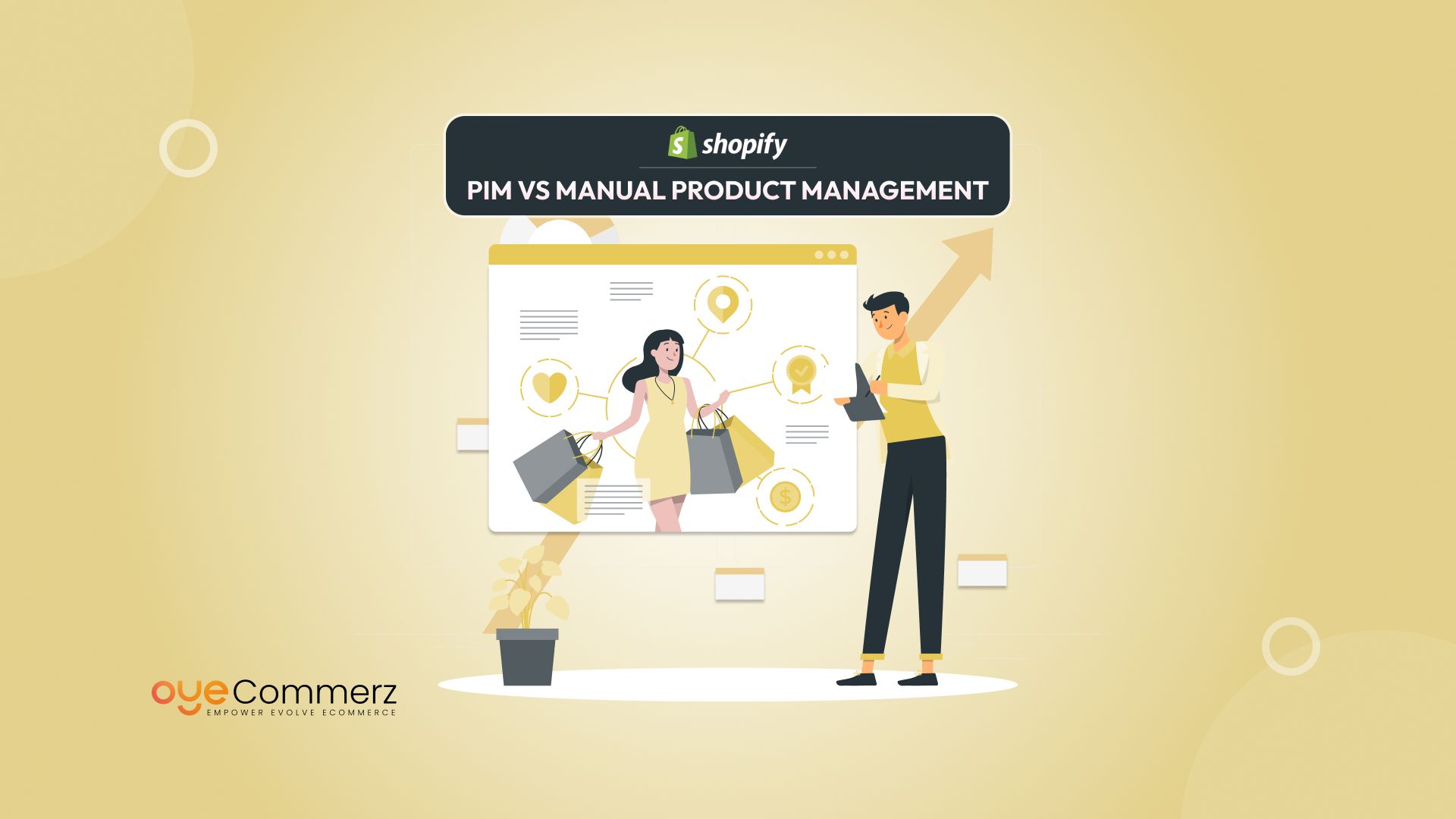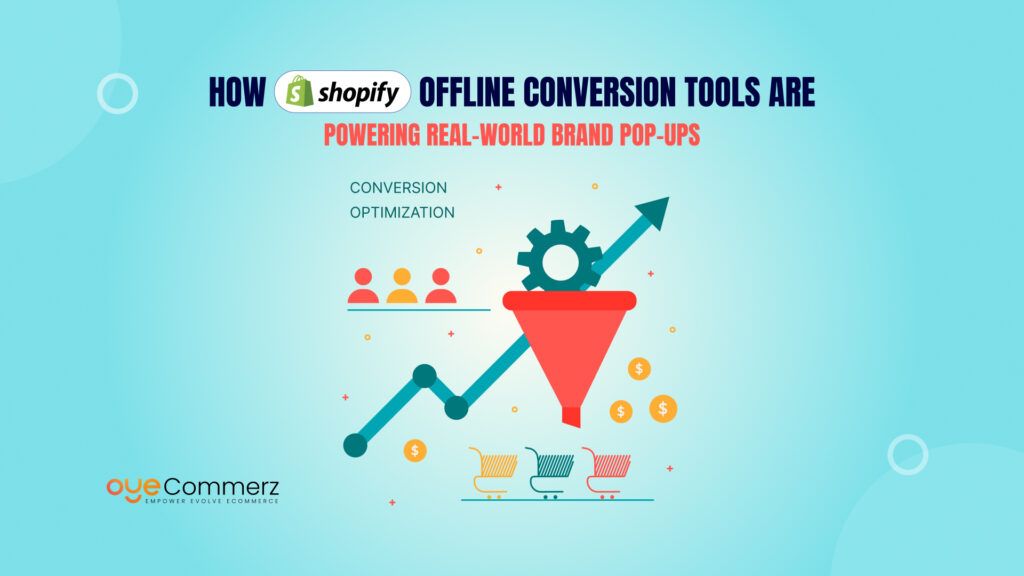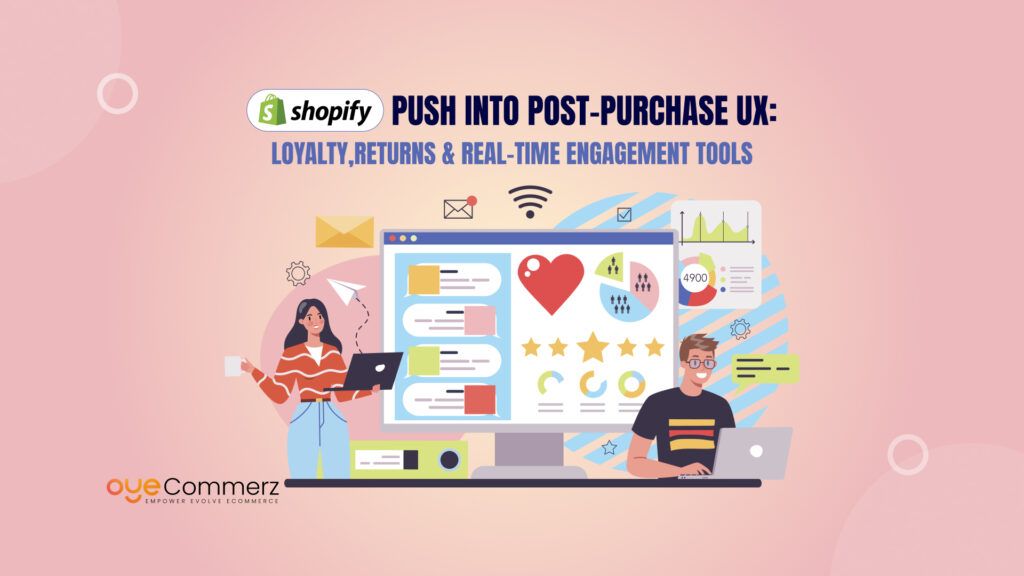Managing product data on Shopify might seem simple—until your catalog grows, your channels multiply, and you start spending more time updating spreadsheets than making sales.
In fact, more than 30% of e-commerce businesses lose revenue due to inaccurate or inconsistent product information. From missed updates to outdated images, manual errors can quietly cost you thousands.
That’s where the debate around Shopify PIM vs Manual Product Management gets serious. Should you stick to doing things by hand, or is it time to level up with a Product Information Management (PIM) solution?
In this blog, we’ll break down everything—from basic definitions to technical comparisons—so you can make the right call based on your business size, goals, and growth plans. Whether you’re running a small shop or scaling a full-blown product empire, the right product management strategy can be a game-changer.
Table of Contents
ToggleUnderstanding the Basics – For E-commerce Beginners
If you’re just getting started with an online store, you’ve probably come across the terms Shopify PIM vs Manual Product Management and wondered what they really mean. Before we dive into comparisons, let’s break it down in simple terms.
What is Product Management in E-commerce?
At its core, product management in e-commerce refers to how you organize, update, and present your products on your online store. This includes:
- Product titles and descriptions
- Images and videos
- Prices and inventory
- SKUs, tags, and categories
Good product management ensures that your online store stays accurate, consistent, and easy to navigate—for both customers and search engines.
What is Manual Product Management?
Manual product management means you handle all product updates by hand inside your Shopify admin. This includes:
- Uploading products one by one
- Editing product descriptions manually
- Updating inventory for each item separately
- Copy-pasting data across multiple platforms
While this can work for small catalogs, it quickly becomes inefficient and error-prone as your store grows.
What is a Shopify PIM?
A Product Information Management (PIM) system is a centralized software that helps you manage, update, and distribute product data across all your sales channels—from your Shopify store to marketplaces like Amazon, Walmart, and more.
With a Shopify PIM:
- You edit all your product data in one place
- Updates sync automatically to your store and other channels
- You reduce human error and save time with automation
- You can scale your catalog without chaos
Think of it as your digital control center for product content.
Why This Comparison Matters
Choosing between Shopify PIM vs Manual Product Management isn’t just a technical decision—it directly affects your store’s efficiency, speed, and customer experience. Especially in today’s competitive market, how you manage your product data can make or break your growth.
The Problem with Manual Product Management on Shopify
At first glance, managing your products manually in Shopify feels manageable—especially if you only have a few items. But as your catalog grows, manual workflows can quickly spiral out of control.
The Hidden Complexity of “Simple” Tasks
When you’re doing everything by hand, here’s what product management looks like:
- Logging into your Shopify admin for every product change
- Copying and pasting descriptions, titles, or specs for each new SKU
- Uploading the same images across multiple variants
- Manually syncing product updates across Shopify and other platforms (like Amazon or eBay)
It may work for a 10-product store. But if you’re managing 100, 500, or 1,000+ SKUs? It becomes a full-time job—and a risky one.
Why Manual Product Management Falls Apart as You Scale
Manual methods lead to:
- Human Error – Inconsistent data, wrong pricing, broken image links
- Wasted Time – Repeating the same tasks across multiple products and platforms
- Poor Collaboration – Team members stepping on each other’s changes
- SEO Inconsistency – Outdated or unoptimized metadata hurting rankings
- Channel Chaos – Different versions of the same product across your website and marketplaces
One wrong copy-paste can create major confusion for your customers—and cost you sales.
Real Talk: You Can’t Grow and Micro-Manage
If your long-term vision includes growing your product catalog, expanding into new channels, or streamlining operations, manual product management simply won’t scale.
That’s where the Shopify PIM vs Manual Product Management comparison becomes more than a convenience—it becomes a strategy for survival.
The Growing Pains – When Manual Management Fails
Manual product management might feel fine in the beginning—but growth changes everything.
As your business expands, so does your product catalog. You introduce new collections, bundle products, or start selling on platforms like Amazon, Walmart, or Etsy. Suddenly, what used to be a quick edit becomes a logistical nightmare.
The Shopify Scaling Scenario: A Cautionary Tale
Imagine this:
- You’re a fashion retailer with 2,000 SKUs.
- New seasonal launches mean updating descriptions, tags, images, and prices—fast.
- You need these updates to reflect on Shopify, Amazon, and Google Shopping.
- And your marketing team is also requesting SEO-optimized titles.
What happens?
- Products get updated on one channel but not the others
- Errors sneak in—wrong colors, missing sizes, duplicate listings
- Your team wastes days tracking down who changed what, where
- Customers get frustrated by inconsistencies, and conversions drop
This is the reality of manual product management—fragile, fragmented, and frustrating.
Compounding Problems Over Time
- Version Control Issues: Multiple team members making updates leads to confusion
- Inventory Sync Delays: Out-of-stock items still showing as available
- Inaccurate Listings: Leading to returns, refunds, and poor reviews
- SEO Penalties: Duplicate content and broken product pages
Each issue might seem small on its own. But together, they create a snowball effect that can seriously slow down your growth—or worse, damage your brand reputation.
💡 Why This Matters in the Shopify PIM vs Manual Product Management Debate
Manual management may seem like the “budget-friendly” approach, but in reality, it often costs you more—in time, resources, and lost revenue. If your team spends more time fixing mistakes than selling products, it’s a clear sign you’ve outgrown the manual method.
Shopify PIM – A Smarter Solution
If manual product management is holding your business back, a Product Information Management (PIM) system could be the key to unlocking operational efficiency and growth. In the conversation around Shopify PIM vs Manual Product Management, this is where the PIM solution clearly begins to stand out.
What is a Shopify PIM?
A Shopify PIM is a centralized platform that allows businesses to manage all product data—descriptions, images, pricing, tags, SEO fields, inventory, and more—from a single interface. It’s built for scale, speed, and synchronization.
Rather than logging into multiple systems or editing each product manually, a PIM enables you to:
- Edit and enrich product data in bulk
- Automate updates across Shopify and other channels
- Maintain consistency in product content and brand voice
- Streamline workflows between marketing, merchandising, and operations teams
It’s the difference between working in your store and working on your business.
How a Shopify PIM Solves Manual Management Problems
- Centralized Control
All product data is managed in one place, eliminating the need to juggle spreadsheets, emails, or multiple browser tabs. - Bulk Editing and Automation
Update thousands of SKUs in minutes instead of hours. Apply changes to product attributes, pricing, or metadata with a few clicks. - Omnichannel Consistency
Ensure that every product is represented accurately and consistently across Shopify, Amazon, Google Shopping, and other platforms. - Reduced Human Error
Minimize manual input by leveraging automation rules, templates, and validation settings to catch common mistakes before they go live. - Faster Time to Market
Launch new products or collections quickly, with structured workflows that keep everything on track. - SEO Optimization at Scale
Manage SEO fields across hundreds of products from one dashboard—ideal for large catalogs or content-driven e-commerce strategies.
Shopify PIM vs Manual Product Management: The Turning Point
As your business scales, the value of a PIM multiplies. It shifts your team from reactive firefighting to proactive growth. Manual systems struggle to keep up with the demands of a multi-channel, content-rich e-commerce operation. A Shopify PIM is built for exactly that.
Contact to Migrate your Site to Shopify Now
Shopify PIM vs Manual Product Management – A Side-by-Side Comparison
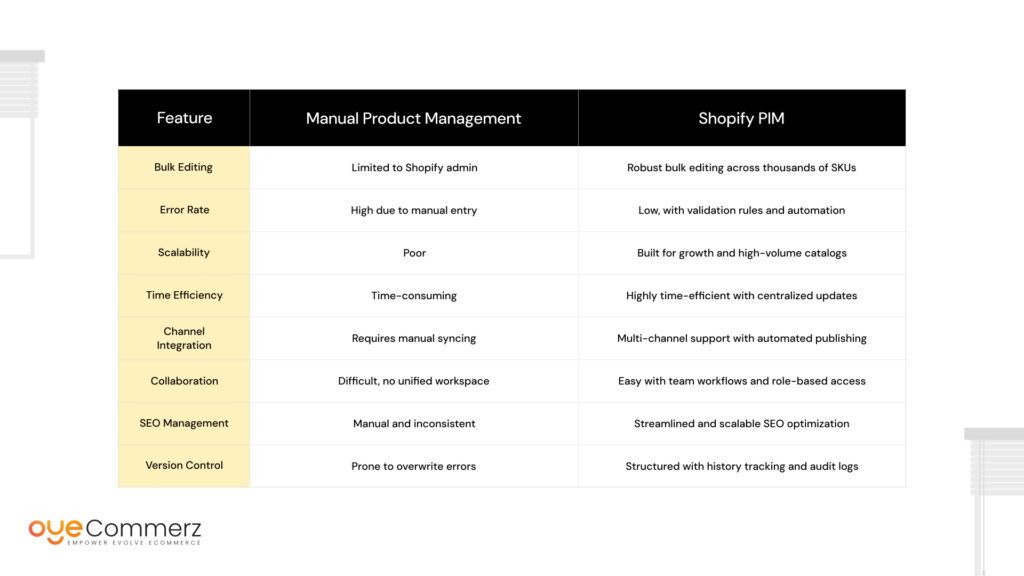
When evaluating Shopify PIM vs. Manual Product Management, the differences become more obvious as your catalog, team, and sales channels grow. This comparison table highlights the key distinctions across performance, efficiency, and scalability.
What This Means for Your Business
If you are managing a small store with fewer than 50 products, manual processes might still be manageable. But for businesses handling frequent product updates, working with multiple team members, or expanding into new channels, manual management quickly becomes a bottleneck.
In contrast, a Shopify PIM provides the infrastructure needed to maintain accuracy, save time, and scale your operations efficiently. It’s not just about simplifying workflows—it’s about creating a more resilient and growth-ready business.
Who Needs a Shopify PIM—and Who Doesn’t?
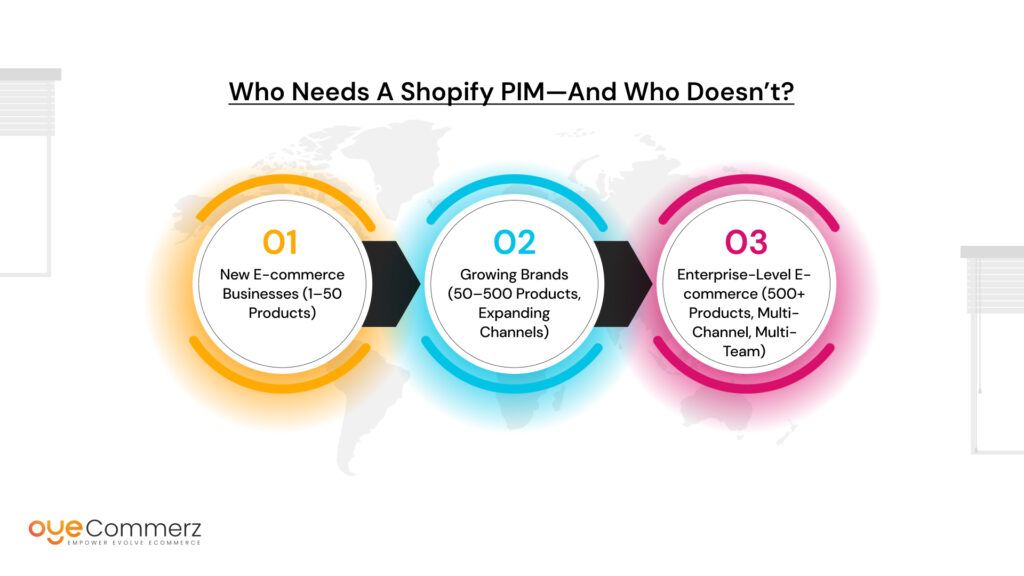
Choosing between Shopify PIM vs Manual Product Management isn’t a one-size-fits-all decision. The right solution depends on the size of your catalog, your business model, and how quickly you plan to scale.
This section will help you identify which stage your business is in and what type of product management strategy makes the most sense.
1. New E-commerce Businesses (1–50 Products)
You’re just starting out, possibly running a single Shopify store with a small catalog. You manage most tasks yourself or with a small team.
Best Fit: Manual Product Management
Manual input can be sufficient if your catalog is limited and changes are minimal. Shopify’s built-in admin tools allow you to upload products, make simple edits, and manage inventory without external systems.
What to Watch For:
As your catalog or team grows, inefficiencies may start to appear. Keep an eye on how long product updates take and how often errors creep in.
2. Growing Brands (50–500 Products, Expanding Channels)
Your catalog is growing, and you’ve started selling on multiple platforms or working with a larger team. Frequent updates and launches are becoming part of your workflow.
Best Fit: Shopify PIM
At this stage, manual methods become unsustainable. A PIM allows you to manage product data centrally, push updates across all channels, and eliminate repetitive tasks. It’s ideal for ensuring brand consistency and minimizing human error.
3. Enterprise-Level E-commerce (500+ Products, Multi-Channel, Multi-Team)
You manage thousands of SKUs, sell across multiple channels (Shopify, Amazon, eBay, etc.), and have dedicated teams for marketing, product, and fulfillment.
Best Fit: Shopify PIM
Manual management is no longer viable at this scale. A PIM provides the infrastructure to handle complex catalogs, automation to speed up workflows, and user roles to support collaboration across departments.
Shopify PIM vs Manual Product Management: Make the Right Choice Based on Stage
The choice between Shopify PIM vs Manual Product Management is not just about features—it’s about alignment. Align your tools with your current needs, but always plan for the next stage of growth. Businesses that scale efficiently are the ones that invest in the right systems at the right time.
Oyecommerz – Your Partner in Smarter Shopify Growth
Making the leap from manual processes to a more structured product management system doesn’t just require better tools—it requires expert guidance. Whether you’re still debating Shopify PIM vs Manual Product Management, or you’re ready to scale your Shopify operations, Oyecommerz can help you make that transition seamless and strategic.
Why Partner with Oyecommerz?
At Oyecommerz, we specialize in helping e-commerce brands:
- Migrate smoothly from platforms like Magento to Shopify
- Implement scalable solutions like Shopify PIM for catalog management
- Optimize store performance for growth and operational efficiency
- Ensure multi-channel consistency and faster time to market
Our team understands the day-to-day challenges of managing large product catalogs. We don’t just migrate your store—we help you optimize it for long-term success with the right tools, automation, and structure.
Our Expertise Includes:
- End-to-end Shopify migration and setup
- PIM integration consultation and implementation
- Custom Shopify theme development
- Ongoing maintenance and performance tuning
Whether you’re an established brand or scaling startup, we align your operations with your business goals—helping you move beyond outdated manual systems and into a smarter, streamlined future.
Ready to Make the Shift?
If you’re weighing the benefits of Shopify PIM vs Manual Product Management, Oyecommerz can help you find the best-fit solution for your business model, catalog size, and growth trajectory.
Visit Oyecommerz’s Shopify Services to start your transformation today.
Conclusion
In the debate of Shopify PIM vs Manual Product Management, it’s clear that as your business grows, a shift from manual processes to a Product Information Management (PIM) system becomes not only beneficial but essential. The challenges of maintaining accuracy, efficiency, and scalability with manual product management simply become too great as you scale your catalog, expand across channels, and grow your team.
The Takeaway: Choose Smart Solutions for Sustainable Growth
- Manual Product Management can work for small, simple stores, but quickly becomes inefficient, error-prone, and time-consuming as your business scales.
- Shopify PIM is the smart, scalable solution that allows you to automate updates, ensure consistency across platforms, and significantly reduce manual errors—freeing your team to focus on growth, not constant data entry.
If you’re ready to streamline your operations and set up your Shopify store for long-term success, Oyecommerz is here to help you transition smoothly, whether you’re migrating to Shopify or integrating a PIM system.
Ready to Transform Your Shopify Experience?
Make the shift from manual to efficient product management today. Visit Oyecommerz Shopify Services to learn more about our migration, optimization, and support services. Let us guide you toward a more streamlined and scalable e-commerce future.
Frequently Asked Questions
A Shopify PIM (Product Information Management) system helps manage, centralize, and streamline all product data, from descriptions and images to inventory levels and pricing. It enables businesses to update and distribute product information across multiple sales channels, reducing errors and saving time.
Switching from manual product management to a Shopify PIM can drastically improve efficiency and accuracy. A PIM automates the process of updating product details across Shopify and other platforms, eliminating human error, saving time, and ensuring consistency in product listings, which is crucial as your store grows.
erience (UX), optimizing product pages with clear descriptions and high-quality images, simplifying the checkout process, and ensuring your site is fast and mobile-friendly. Additionally, implementing effective email marketing and abandoned cart recovery strategies can significantly improve conversions.
Yes, one of the key benefits of Shopify PIM is its ability to integrate with multiple sales channels. This includes not only your Shopify store but also third-party platforms like Amazon, eBay, and Google Shopping. This ensures consistent and up-to-date product information across all your sales platforms, improving customer experience and reducing operational workload.
A Shopify PIM can enhance SEO by ensuring that all product data is consistent, complete, and optimized for search engines. With features like automated meta tag management, keyword-rich descriptions, and bulk updates, PIM systems can help improve your product visibility and search rankings, driving more organic traffic to your Shopify store.
what they expect when they land on your site. To reduce bounce rates, focus on optimizing your homepage and landing pages for relevance, speed, and user-friendliness. Ensure that your site loads quickly, your content matches visitors’ expectations, and your design encourages them to explore further.
Manual product management on Shopify can lead to issues such as inconsistent product data, time-consuming updates, human errors, and inefficiencies. As your business scales, these problems multiply, leading to missed opportunities, customer dissatisfaction, and lost revenue. Shopify PIM provides an effective solution by automating and centralizing product management tasks.

